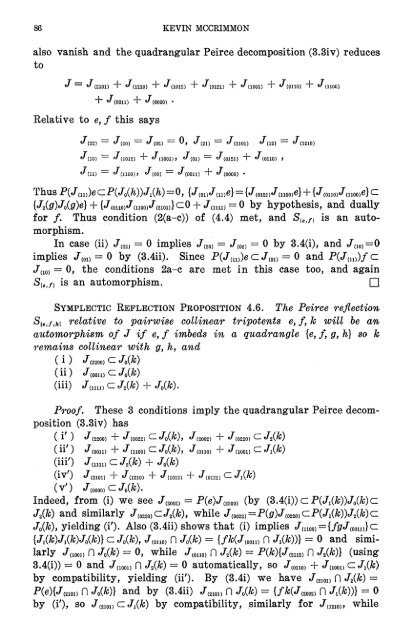Compatible Peirce decompositions of Jordan triple systems - MSP
Compatible Peirce decompositions of Jordan triple systems - MSP
Compatible Peirce decompositions of Jordan triple systems - MSP
Create successful ePaper yourself
Turn your PDF publications into a flip-book with our unique Google optimized e-Paper software.
86 KEVIN MCCRIMMON<br />
also vanish and the quadrangular <strong>Peirce</strong> decomposition (3.3iv) reduces<br />
to<br />
J z=Z J ( 2 1 0 1 ) + e/( 12io) + e/{lO12) + ^(0121) + ^(1001) + J (0110) 4" J (Π00)<br />
~Γ ^(0011) ~f"~ ^(0000)<br />
Relative to e, f this says<br />
e/(22) — «M20) = = ^(02) ~ "> ^(21) ~ «M2101) ** (12) = = e' (1210)<br />
^(10) — «M1O12) + e/(1001)> «* (01) — ^(0121) + «* (0110) 9<br />
Λ = = ^ ) > β'(OO) = = ^(0011) + e'(OOOO)<br />
Thus P(J (n))e(zP(J 0(h))J 1(h)=0, {J (01,J (u,e} = {J (OIM)^αiooϊβ} + {/ (ono)^(πoo)β} c<br />
{e7' 2(^)J r o(α)e} +{^(0110)^(1100)^(2101)}cθ + e7 (nii) = 0 by hypothesis, and dually<br />
for /. Thus condition (2(a-c)) <strong>of</strong> (4.4) met, and S {etf) is an automorphism.<br />
In case (ii) J (22) = 0 implies J m = J m = 0 by 3.4(i), and / (10)=0<br />
implies J m = 0 by (3.4ii). Since P(J [n))edJ m) = 0 and P(/ (11))/c<br />
^(io) = 0, the conditions 2a-c are met in this case too, and again<br />
S [e, f} is an automorphism. •<br />
SYMPLECTIC REFLECTION PROPOSITION 4.6. The <strong>Peirce</strong> reflection<br />
S{e,f,ki relative to pairwise collinear tripotents e, f, k will be an<br />
automorphism <strong>of</strong> J if e, f imbeds in a quadrangle {e, /, g, h) so k<br />
remains collinear with g, h, and<br />
(i) J (2200) c J 0(k)<br />
( U ) J(oon) C J Q(k)<br />
(iii) Jαπ,) c J 2 (Λ) + J 0 (k).<br />
Pro<strong>of</strong>. These 3 conditions imply the quadrangular <strong>Peirce</strong> decomposition<br />
(3.3iv) has<br />
( 1 ) β' (2200) + ^(0022) aJ 0(tG)f «/( 2002) + «M0220) ^ e/ 2(Aj)<br />
(.11 ) e/(0011) "I" «^ (1100)<br />
(iii') / (1111)cJ 2(&)<br />
(lV ) e/( 2101 ) + e/ (1210 )<br />
(V) /(oooo) CJ β(fc).<br />
Indeed, from (i) we see e7 (2002) = P(e)J {2200)<br />
(by (3.4(i))cP(J 1(&))J 0(A;)c<br />
and similarly J (O8 2o, cJ*(fc), while J (0 022)~-P(^)J r<br />
(022o)C:P(e7 1 (&))J 2 (&)c<br />
), yielding (i') Also (3.4ii) shows that (i) implies / (11O o) = i/i/J r<br />
(oolJ) }c<br />
{/,(&)J/fc)Jo(&)} c J 0 (fc), J ( oπo) Π Jo(fc) = {/AMoon) Π JΊ(fc))} = 0 and similarly<br />
e7 (1O oi) Π Jo(ft) = 0» while J (0110) Π e/ 2 (A) = P(k){J {2m) Π e7" 2 (fc)} (using<br />
3.4(i)) = 0 and J (100 i) Π / 2 (&) = 0 automatically, so J (0110 ) + Jn m)<br />
c J^ifc)<br />
by compatibility, yielding (ii'). By (3.4i) we have J" (8101, Π J 2(k) =<br />
P(β){J»ioi) Π /o(fc)} and by (3.4ii) J (2101) n J 0(fc) = {fk(J mm<br />
Π JiC*))} = 0<br />
by (i'), so J" (2101 ) c Ji(fc) by compatibility, similarly for J" U210) , while













